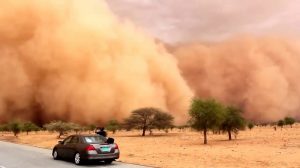Sand and dust storms are an underappreciated problem now “dramatically” more frequent in some places worldwide, with at least 25% of the phenomenon attributed to human activities, according to the UN Convention to Combat Desertification (UNCCD).

Accompanied by policy recommendations, the warning comes as a five-day meeting takes place in Samarkand, Uzbekistan to take stock of global progress in the Convention’s implementation. The UNCCD is one of three Conventions originated at the 1992 Earth Summit in Rio de Janeiro. The other two address climate change (UNFCCC) and biodiversity (UN CBD).
The meeting, holding November 13 to 17, 2023, includes a high-level session on November 15 hosted by the Government of Uzbekistan on ways to address the impacts of sand and dust storms on global agriculture, industry, transportation, water and air quality, and human health.
Says Ibrahim Thiaw, UNCCD’s Executive Secretary: “The sight of rolling dark clouds of sand and dust engulfing everything in their path and turning day into night is one of nature’s most intimidating spectacles. It is a costly phenomenon that wreaks havoc everywhere from Northern and Central Asia to sub-Saharan Africa.”
“Sand and dust storms present a formidable challenge to achieving sustainable development. However, just as sand and dust storms are exacerbated by human activities, they can also be reduced through human actions,” adds Thiaw.
While sand and dust storms (SDS) are a regionally common and seasonal natural phenomenon, the problem is exacerbated by poor land and water management, droughts, and climate change, according to UNCCD experts.
And fluctuations in their intensity, magnitude, or duration “can make SDS unpredictable and dangerous.”
With impacts far beyond the source regions, an estimated 2 billion tons of sand and dust now enters the atmosphere every year, an amount equal in weight to 350 Great Pyramids of Giza.
In some areas, desert dust doubled in the last century.
“Sand and dust storms (SDS) have become increasingly frequent and severe having substantial transboundary impacts, affecting various aspects of the environment, climate, health, agriculture, livelihoods and the socioeconomic well-being of individuals. The accumulation of impacts from sand and dust storms can be significant,” says Feras Ziadat, Technical Officer at the Food and Agriculture Organisation of the UN (FAO), Chair of the UN Coalition on Combating Sand and Dust Storms.
“In source areas, they damage crops, affect livestock, and strip topsoil. In depositional areas atmospheric dust, especially in combination with local industrial pollution, can cause or worsen human health problems such as respiratory diseases. Communications, power generation, transport, and supply chains can also be disrupted by low visibility and dust-induced mechanical failures. The United Nations Coalition on Combating Sand and Dust Storms, currently chaired by FAO, was created in 2019 to lead global efforts to tackle SDS.”
In their Sand and Dust Storms Compendium and accompanying SDS Toolbox, UNCCD, FAO and partners offer guidance on approaches and methodologies for collecting and assessing SDS data, monitoring and early warning, impact mitigation and preparedness, and source mapping and anthropogenic source mitigation at sub-national, national, regional and global levels.
The SDS discussion forms part of the agenda of this year’s meeting in Uzbekistan of the UNCCD’s Committee for the Review of the Implementation of the Convention (CRIC 21) and global progress in delivering the Convention’s strategic objectives. It marks the first time since its establishment that UNCCD has convened one of its most significant meetings in Central Asia.
The meeting comes at a critical juncture, as recent statistics published via UNCCD’s new data dashboard shows the world now losing nearly 1 million square kilometres of healthy and productive land every year – some 4.2 million square kilometres between 2015-2019, or roughly the combined area of five Central Asian nations: Kazakhstan, Kyrgyzstan, Tajikistan, Turkmenistan and Uzbekistan.
